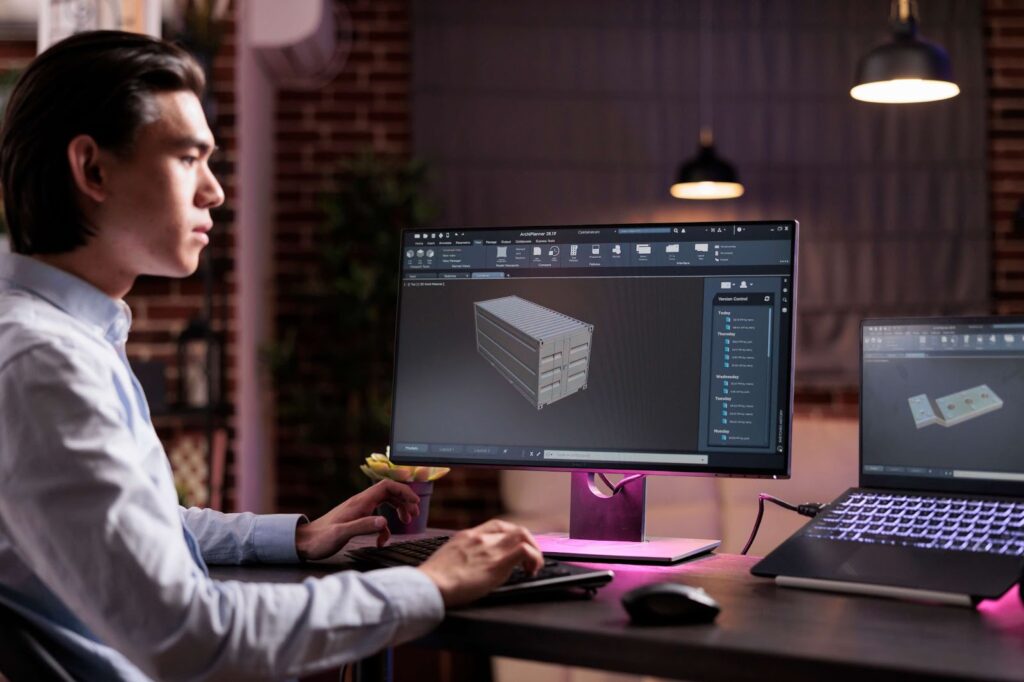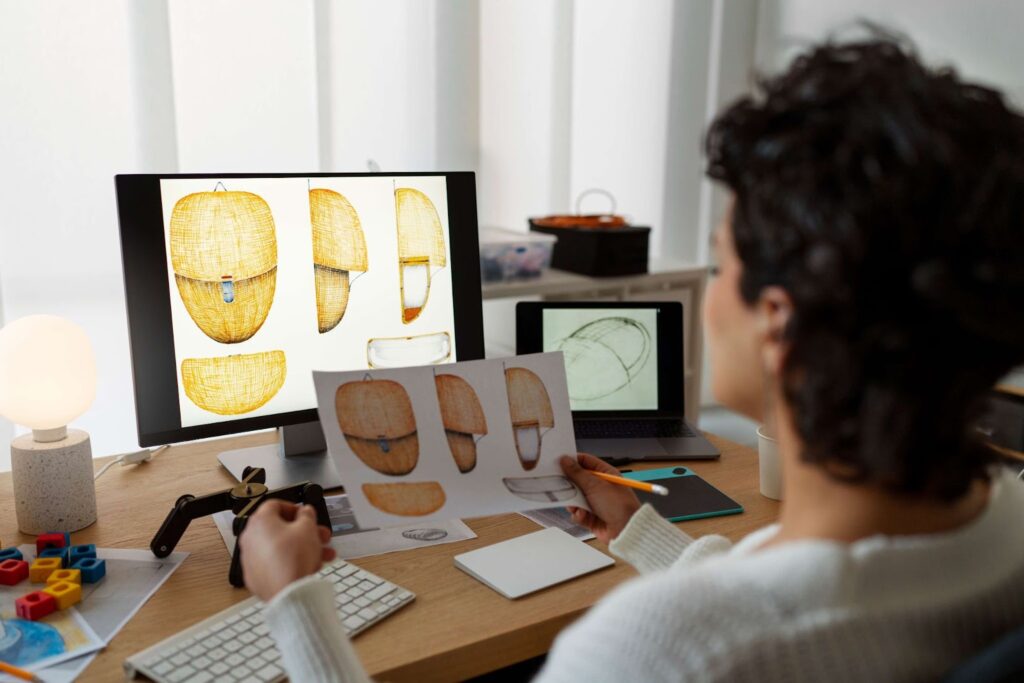In the realm of professional 3D artists, the realization that crafting a 3D model constitutes no mere trivial endeavor has taken root. It is an intricate process that involves the orchestration of numerous elements, each playing a vital role – from the nuanced texture of an object to its appearance under various illuminations. Achieving an authentic representation of the subject matter demands a thorough study and a deep-seated comprehension of its essence.
To enhance their grasp of the object’s essence, modelers adeptly employ image references. These visual aids serve as windows into the object’s multifaceted aspects, including its texture and behavior under diverse lighting conditions. Consideration of minute design details, functional attributes, and user interactions is a paramount aspect of the modeling process. A symphony of meticulous analysis is required to bring forth a lifelike manifestation of the subject.

Unleashing the World of 3D Modeling Image References – Unraveling the Digital Realism!
Welcome to the fascinating realm of 3D modeling, where the digital world seamlessly converges with reality. Here, we’ll take you on an exhilarating journey, exploring the art of creating lifelike digital representations of objects that can be used for various purposes, ranging from redesigning existing products to breathing life into entirely new creations.
Imagine having the power to virtually recreate any object with precision, detail, and accuracy, all in the realm of digital creativity. Well, with 3D modeling, this is not a distant dream but a tangible reality. Whether you’re a retailer seeking to revolutionize your product presentation or a brand eager to stand out with custom offerings, 3D modeling has got your back.
Gone are the days of relying solely on traditional drawing or photography to prototype and market products. The era of 3D modeling has ushered in a cost-effective solution that allows businesses to unleash their creativity without breaking the bank. Through this innovative technology, companies can transcend the boundaries of imagination, turning their ideas into tangible, interactive virtual prototypes that captivate their audience.
While the possibilities are limitless, venturing into the world of 3D modeling requires a bit of know-how. Before diving headfirst into this exciting realm, manufacturers and marketers must equip themselves with the necessary understanding of how to work with these technologies effectively.
So, if you’re ready to embark on an exciting journey where creativity knows no bounds, fasten your seatbelts, and let’s delve into the captivating world of 3D modeling image references. Get ready to be inspired, motivated, and equipped to take your brand to unprecedented heights!
Unlocking the Secrets of 3D Modeling Image References
The Power of 3D Modeling Image References
Imagine a world where artists could bring their wildest imaginations to life, where they could sculpt, design, and animate objects with stunning realism. Well, welcome to the realm of 3D modeling! At the heart of this mesmerizing craft lies a magical tool known as “3D modeling image references.” These references are not just ordinary images; they are the keys that unlock a whole new dimension of creativity for 3D artists.
In essence, 3D modeling image references encompass a diverse collection of visual aids, ranging from photographs and drawings to models and material samples. Each reference serves a crucial purpose: to enrich an artist’s understanding, fuel their inspiration, and enable them to delve deeper into the intricacies of their work. By providing an intricate roadmap, these references guide artists in comprehending the structure of objects, the assembly of elements, and the interplay of light and shadow.
The Quest for the Perfect Reference – Quantity Matters
Now, you might be wondering, “How many references should I wield in my artistic arsenal?” The answer lies in the complexity of your project and the degree of clarity you wish to achieve. For instance, envision crafting a simple 3D model of a cozy kitchen table and chairs. Here, three references might suffice to steer you in the right direction. However, brace yourself for more ambitious endeavors, such as creating intricate architectural wonders or lifelike character models. Such masterpieces demand an army of references, as many as you can muster, to ensure accuracy and attention to detail.
Unraveling the Secrets of Selecting Supreme References
Ah, but tread carefully, for choosing the crème de la crème of 3D modeling image references is no mere trifling task. The vast expanse of the internet offers a plethora of choices, and discerning the right ones can be an artistic odyssey in itself. Fret not, for we are here to equip you with indispensable tips to make the best possible choices.
- Quality Reigns Supreme: If there’s one attribute that reigns supreme, it’s image quality. A low-resolution image is the nemesis of every 3D artist, causing pixelated and blurry nightmares. To save yourself from such horrors, opt for medium- or high-quality photos boasting a minimum resolution of 2000×2000 pixels. Embrace clarity and say goodbye to fuzziness!;
- The Mighty DPI: DPI (dots per inch) is the knight in shining armor, enhancing the majesty of your references. Look for images with a resolution of 72 DPI or higher, for they wield the power to elevate your creations to awe-inspiring heights. As the resolution and size of the images escalate, so too shall the precision of your final masterpiece;
- From Every Angle: A treasure trove of angles awaits your perusal. Seek out references that showcase an object or subject from multiple viewpoints. A minimum of five views is indispensable, but if you truly crave perfection, cast your net wider and aim for ten or more angles. The more you have at your disposal, the more accurately you can conjure the essence of your creation;
- Mind the Copyright Chasm: Danger lurks in the shadows of copyright restrictions. While exploring the vast landscape of references, exercise caution and ensure you traverse only the paths that welcome your creativity. If the licensing information remains shrouded in mystery, turn away and seek alternative avenues. Let your art be free, unburdened by legal quandaries;
- Chasing the Light and Shadow: As the sun casts its tender rays and shadows play hide-and-seek, so too should your reference images capture the magic of lighting. Choose images that boast impeccable lighting and shadows, for they hold the key to transforming flat 2D images into breathtakingly realistic 3D marvels.
Essential Guidelines for Superlative 3D Modeling Image References
In the realm of crafting exceptional 3D models, the artistry heavily relies on having accurate and comprehensive image references. These visual blueprints serve as guiding beacons for 3D artists, enabling them to fashion lifelike and visually breathtaking digital assets. To attain top-notch 3D modeling image references, keep in mind the following essential criteria:

Diverse Perspectives: A 360-Degree Panorama of Products
A solitary static image merely scratches the surface of an object’s essence. To unlock the full potential of 3D modeling, it is imperative to present multiple angles of the product. The broader the array of perspectives an artist possesses, the better they can comprehend every intricate detail and dimension of the design.
Without comprehensive references, artists may struggle to create accurate models, resulting in lackluster outcomes. By offering various angles, including front, back, sides, and top-down views, you empower artists to grasp the product’s essence from every vantage point, facilitating the creation of truly immersive 3D models.
Proportions: The Bedrock of Realism
The significance of proper proportions cannot be overstressed in 3D modeling. A model that fails to capture realistic dimensions will invariably appear artificial and disjointed, irrespective of its other artistic merits. To achieve authenticity, it is best to base proportions on real-world measurements whenever possible.
In the absence of real-world measurements, artists can employ ratios to accurately determine proportions. For instance, comparing the height and width of an object allows the artist to establish the correct ratio, assisting in maintaining the proper scale. Additionally, juxtaposing various products in a photograph helps artists visualize and comprehend the relative sizes of the objects.
Illumination: Lighting the Path to Realism
Lighting plays a pivotal role in bringing 3D models to life. It enables artists to perceive the shape, shadows, and material colors, ensuring a lifelike representation. To provide effective image references, it is essential to grasp the specific lighting requirements of 3D artists.
A well-executed lighting setup in the reference images should adhere to three fundamental principles:
a) The light source should be positioned above the camera, emulating natural lighting conditions;
b) The light source should cast shadows on one side of the object, creating depth and dimensionality;
c) The shadows should be soft, striking the right balance between darkness and visibility.
By adhering to these principles and offering well-lit reference images, artists can work their magic and breathe life into the 3D models they create.
Materials and Textures: The Foundation of Realism
The materials and textures applied to an object significantly influence how light interacts with its surface. CG artists require comprehensive knowledge about the materials they depict to accurately render them in their 3D models. Thus, providing material samples or high-quality images of textures becomes paramount.
Whether it involves capturing the gleam of a polished metal surface or the transparency of glass, the right materials and textures elevate a good 3D model into a phenomenal one. For those seeking to enhance their material and texture collection, exploring dedicated 3D modeling texture resources can open up a world of creative possibilities.
Intricate Details: Unveiling the True Essence of Designs
As the saying goes, the devil is in the details, and this holds true for 3D modeling as well. Image references that boast intricate details serve as treasure troves of information for artists, enabling them to grasp every nuance of the design.
Close-up shots prove invaluable for showcasing fine details, while wide shots provide context, aiding in a better overall understanding of the design. Striking the right balance between close-ups and wide shots grants 3D artists the necessary insights to craft stunning models that encapsulate the essence of your creation.
Conclusion
In conclusion, reference images play a vital role in the process of 3D modeling, serving as invaluable guides that enable artists and designers to transform their ideas into breathtaking three-dimensional creations. Throughout this article, we have explored the significance of using reference images, which serve as a solid foundation for modeling complex shapes, ensuring accuracy, and maintaining visual consistency in the final product.